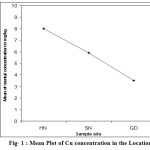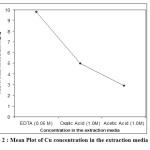Chemical studies on dumpsite soils (with specific focus on Cu (copper) level) within Municipal Area of Sidhi Town, District Sidhi (M.P.) India
Vinod Dubey1*, Dhanajai Singh2, Aparna Panday1
DOI : http://dx.doi.org/10.13005/ojc/300476
Article Received on :
Article Accepted on :
Article Published : 30 Dec 2014
The soil of dumpsite situated at HN (Hiran Nalla), SN (Sukha Nalla) and GD (Gopaldas Dam) within the municipal area of Sidhi town have been chemically analyzed for ascertaining the level of Cu (copper). The analysis was done using EDXRF (Energy dispersive x-ray fluorescence) and AAS (Atomic absorption spectrophotometer). The result obtained showed that HN had the highest total Cu concentration followed by SN and GD. From the ANOVA (Analysis of Variance) it was indicated that there is no significant difference in the total Cu concentration across the three locations. From the result it was also established that the metal was distributed between oxide, carbonate and carbonate/organically bound fractions and that EDTA extracted the highest Cu concentration across the dumpsite. Similarly the ANOVA also indicated a significant different in the Cu extracted by the threes extraction medium.
KEYWORDS:Copper; Dumpsite; Analysis; EDXRF; AAS and ANOVA
Download this article as:| Copy the following to cite this article: Dubey V, Singh D, Panday A. Chemical studies on dumpsite soils (with specific focus on Cu (copper) level) within Municipal Area of Sidhi Town, District Sidhi (M.P.) India. Orient J Chem 2014;30(4). |
| Copy the following to cite this URL: Dubey V, Singh D, Panday A. Chemical studies on dumpsite soils (with specific focus on Cu (copper) level) within Municipal Area of Sidhi Town, District Sidhi (M.P.) India. Available from: http://www.orientjchem.org/?p=6349 |
Introduction
The Sidhi town is undergoing rapid development in respect of population, industrialization and urbanization since its establishment and therefore resulting into various problems. Out of all problems the problem of waste management by municipality is facing a serous challenge. Presently the waste collected and disposed off in uncontrolled manner at dumpsite, same times the waste be burnt. But in this way the whole environment are being polluted. The levels of heavy metals in the environment have been seriously increased during the last few decades due to human activities. It is important to note that total heavy metal content is a critical measure in assessing risk of a waste present at dumpsite.
The aim of this work was to analyzed the various chemical form of copper present in waste at dumpsite for assessing its impact on human health and on the ecology of the area concerned.
Material and Methods
For determining the concentration of Cu a flame atomic absorption spectrophotometer and energy dispersive x-ray fluorescence spectrometer were used and for the extraction procedure 1.0 M oxalic acid, 0.05 M Na2 EDTA and 1.0 M acetic acid were used.
This research work covered three dumpsite, one each at HN (Hiran Nalla), SN (Sukha Nalla) and at GD (Gopaldas Dam) respectively in Sidhi town municipality, these dumpsite are almost situated around residential areas with in municipalities. The sample were collected during rainy season of 2013. Triplicate sample from each dumpsite were collected and then composite sample were prepared in the laboratory.
Digestion and extraction of soil was done by shaking 5 g of soil separately with 0.05M Na2 EDTA (for carbonate and organically bound phase) 1.0M of oxalic acid (for oxide phase) and 1.0M acetic acid (for carbonates phase) occasionally on a hot plate. 4 cm3 of 1.5M HNO3 was added to the residue and centrifuged. The digest was diluted to 60 cm3 with distilled water and the clear digest was analyzed for Cu using FAAS. A blank digest was also carried out in the same way. The total metal concentrations was also determined for various dumpsite by taking 5 g. of fresh sample form each site then it is dried and pulverized and thereafter analyzed using EDXRF spectrometer.
Result and Discussion
The total Cu content in all the three dumpsite have been presented in the table 1 which showed clearcut variation from one site to another site. From the result HN had the highest Cu content followed by SN and GD. The concentration of Cu in all these three dumpsites is having the value above the permissible limit of 100 mg/kg similar investigation was also done by other researchers. From the ANOVA (Analysis of variance), there is no significant difference in the total Cu concentration across the three site.
Table 1Result of Cu concentration in the dumpsite (The result are mean values )
|
Sample Site |
PH |
EDTA (0.05 M) |
Oxalic Acid (1.0M) |
Acetic Acid (1.0M) |
Total Cu concentration mg/kg |
|
HN |
6.11 |
15.52 |
6.10 |
2.89 |
810.00 |
|
SN |
6.20 |
8.17 |
7.38 |
3.13 |
601.53 |
|
GD |
8.38 |
6.21 |
4.00 |
0.98 |
590.32 |
The distribution of Cu in the dumpsite varied form one location to another. It exist in oxide, carbonate and carbonate/organically, bound fractions. The carbonate/organically bound fractions of Cu was found highest in all the three location considered. Therefore the metal is said to be organically found species in these dumpsite and hence bioavailable and mobile in these location. This is in conformity with the result reported by other investigators working in similar situation.
The ph of the dumpsite form two of the location (HN and SN) is acidic while the ph of the GD was alkaline. This could be attributed to the presence of metal parts in the waste at dumpsite and other anthropogenic activities taking place around the dumpsite. EDTA extracted the highest concentration of Cu across the dumpsite as shown in fig.-1. From the ANOVA there is a significant difference in the Copper extracted by three extraction media. Form the Duncan multiple range test, it was also established that the dumpsite at HN had the highest concentration of copper, followed by SN and GD as shown in fig.-2.
 |
Fig1 : Mean Plot of Cu concentration in the Locations |
 |
Fig2 : Mean Plot of Cu concentration in the extraction media
|
Conclusion
This research work reveals that on account of high level of accumulated Cu in the dumpsite soil resulting into pollution of these areas. The imminent danger inherent in continuous pollution of the soil by Cu calls for serious effort toward adequate management of solid waste. The level of heavy metals can be reduced to a reasonable level if solid waste are sorted and the inorganic part recycled.
Reference
- Yusuf, K. A. Sequential extraction of Pb, Cu, Cd, and Zn in soil near ojota waste site Journal of Agronomy, 2007, 6 (2) 331-337.
- Yaman, M., Diliginy and Gucers, Speciation of Pb in soil and relation with its concentration in Fruits, Analytical Chimica. Acta, 2000, 410, 119-125.
- Wieczorek, J., Wieczorek Z. and Bieniasxewski T., Cadmium and lead contant in cerials grain and soil form cropland adjacent to road ways, Polis Journal of Environmental studies, 2005, 14 (4) 535-540.
- Kashem, M. A., Singh B. R., Kondo, S. M. Imamul Hug S.M. and Kawais, Comparison of extractability of Cd, Cu, Pd and Zn with sequential extraction in contaminated soil Int. J. Environ. Sci. tec. 2007, 4 (2) 169-176.
- Turer, D., Maynard J. B. and sonsalorej J., Heavy metal contamination in soils of urban highway, water and soil pollution, 2001, 132, 293-314.
- M.C.Ong, D.Menier, N.A.M.Shazili and B.Y. Kamaruzzaman, Orient.J.Chem. 2013, 29(1), 39-45.

This work is licensed under a Creative Commons Attribution 4.0 International License.









